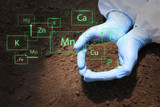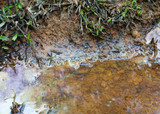The Difference Between In Situ Testing and Lab Analysis
Soil science and environmental monitoring play big roles in making agricultural decisions. In situ testing and lab analysis serve very different purposes. Understanding the difference between these methods is essential when time, cost, and accuracy are on the line.
Equipment and Sampling Tools
In situ testing generally requires minimal equipment. Portable meters can provide immediate readings in the field, but reliable results often begin with collecting a representative soil sample. Our soil augers make it simple to reach consistent depths and retrieve material for quick checks or follow-up lab work.
By contrast, lab analysis always depends on a physical sample. Using a soil auger for soil sampling ensures consistent depth and quality, giving laboratories the material they need to produce accurate results. High-quality samples minimize variability and improve the reliability of lab-based insights.
Testing Speed and Convenience
One of the biggest benefits of in situ testing is speed. Results are available within minutes, which makes field testing useful for quick decisions. For example, consultants may use pH meters to determine whether lime should be applied that same day. Water well installers may use electrical conductivity (EC) probes during drilling to monitor aquifer changes in real time.
Lab testing, on the other hand, typically requires 5–10 business days, not including shipping. The turnaround depends on the complexity of the requested analyses and how far samples must travel to the testing facility. This waiting period isn’t always a drawback, but it does require planning—especially when results are needed before planting, remediation, or construction can move forward.

Accuracy and Sensitivity
Field instruments are designed for speed and practicality, but that comes with trade-offs in precision. A digital pH meter used in the field may give readings within ±0.2 units. That’s sufficient for spotting trends but not ideal for fine-tuning inputs or meeting regulatory standards.
Lab analysis is more sensitive. Tests are run on calibrated equipment by trained technicians, often using standardized procedures certified by state or federal agencies. If a farmer needs to know the exact concentration of nitrate-N in the soil down to parts per million, lab testing is the more appropriate route. Labs provide the ideal conditions for biological assessments, such as microbial activity or nematode counts.
What Can Be Tested
In situ testing is limited to parameters that can be measured instantly or with minimal preparation. These include pH, electrical conductivity, dissolved oxygen, and temperature. Some field kits can also test for nitrate or phosphate, though results are typically semi-quantitative and less precise than lab data.
Lab analysis can evaluate everything a field test can—and much more. It can break down exact levels of macronutrients (phosphorus and potassium), test for trace metals (arsenic or cadmium), and analyze organic content or soil texture. Some compounds, such as heavy metals or pesticide residues, can’t be measured in the field at all. Only lab testing can identify them.
Environmental Conditions and Interference
The biggest limitation of in situ testing is exposure to uncontrolled variables. Recent rainfall, humidity, ambient temperature, and wind can alter readings within minutes. For instance, if soil moisture is high, electrical conductivity readings may spike, giving a misleading picture of nutrient levels.
Even the duration that the probe sits in the soil can affect data quality. Most handheld meters require recalibration every two to four hours to stay accurate, especially when testing across multiple fields or under changing weather conditions.
In contrast, lab testing occurs in a tightly regulated setting. Once collected, samples are sealed in labeled containers, sometimes cooled or stabilized with preservatives, to prevent chemical changes. For nitrate-N or volatile organic compounds (VOCs), the sample must reach the lab within 24–48 hours. Technicians analyze each sample under consistent temperature, humidity, and lighting, eliminating many of the variables that affect field data. That consistency makes lab results more reliable for long-term tracking or regulatory compliance.
Cost and Resource Allocation
In-field testing offers a low-cost, high-frequency option. You can reuse pH strips or digital meters hundreds of times for a one-time purchase. In some agricultural settings, farmers use handheld testers weekly throughout the growing season to track shifts in salinity or pH. This makes in situ testing especially attractive for routine monitoring where trends matter more than individual data points.
Lab analysis, on the other hand, costs more per sample, depending on the number of parameters tested and the lab's turnaround time. Still, the value lies in the depth and extent of the results. A single lab report might detail macronutrients, micronutrients, pH, cation exchange capacity (CEC), organic matter, and microbial activity from one sample. These insights can guide not just immediate decisions but also broader strategies for crop rotation, soil management, and conservation planning. For baseline testing at the start of a season, verifying remediation outcomes, or establishing defensible records for compliance, lab data often pays for itself in reduced guesswork and more efficient resource use.

Data Interpretation and Recordkeeping
Field-based readings usually require on-the-spot interpretation. A grower or consultant takes the reading, compares it to reference values, and makes decisions accordingly. While fast and responsive, in-situ data rarely meets the format requirements for insurance claims, audit trails, or government programs. It also introduces human error because numbers may be logged incorrectly or fail to account for field variability.
Lab data arrives in a standardized report, often accompanied by interpretation notes, detection limits, and quality control documentation. These reports can be stored digitally or submitted directly for compliance. Having traceable and verifiable records is often mandatory for multi-acre operations or projects funded by grants. Labs also retain archived data for future comparison, which is particularly useful when monitoring long-term site changes.
Choosing the Right Fit
In situ testing is commonly used for in-season decision-making, such as adjusting fertilizer after heavy rain, identifying salinity spikes during dry periods, or checking soil temperature before seeding. This form of testing offers a fast path to action when you need quick, localized answers.
Laboratory analysis is more appropriate when accuracy or documentation is the priority. It’s the go-to choice for pre-season nutrient planning, environmental assessments, or confirming the success of a remediation effort. Many professionals combine both methods: start with a quick field test to detect anomalies, then follow up with lab samples for confirmation and deeper insight.
Ask Before You Start
The difference between in situ testing and lab analysis goes beyond methods. Ask yourself: Do I need actionable insight today or data five years from now? Am I troubleshooting a problem on-site or building a defensible record for the long term?
We manufacture tools that help you collect reliable samples for accurate testing—no matter where you’re working or what you’re testing.
Recent Posts
-
Selecting Soil Sampling Tools for Contaminated Site Work
Selecting the right tools for contaminated site work lays the groundwork for valid data and successf …December 10, 2025 -
10 Reasons Testing Groundwater Is Important
Groundwater is one of the most valuable resources we have. It provides drinking water for millions a …November 20, 2025 -
Why You Should Regularly Check Termite Bait Stations
In industries such as agricultural or groundwater management, unseen threats can quietly undermine y …November 12, 2025




